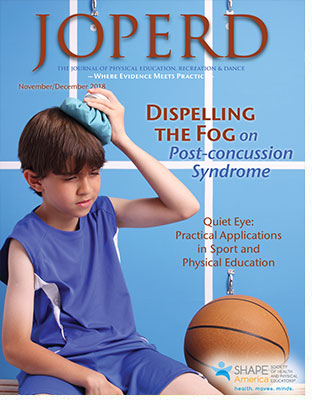 JOPERD Table of Contents
JOPERD Table of Contents
Dispelling the Fog on Post-concussion Syndrome
Patrick Hughes and Kathe Gabel

Academic performance is an area that is often adversely affected in students who have suffered a concussion (Moser, Schatz, & Jordan, 2005). This is especially true of individuals
whose symptoms persist for an extended period of time. Post-concussion syndrome can have very detrimental side effects to these students who attempt to reintegrate into
school too soon. Growing evidence also supports that nutritional factors could play a role in reducing inflammation in the brain after a traumatic injury (Maroon, LePere, Blaylock,
& Bost, 2012). Recommendations for the management of these concussions in the pediatric and adolescent population are inspiring debate and may be creating a fog of confusion
for the frontline caregivers — physical education (PE) teachers, athletic trainers, school nurses, athletic directors, coaches and non–physical education teachers. This article provides information on how to recognize students who may be experiencing post-concussion syndrome, as well as guidelines for a graduated return-to-learn plan.
According to the Centers of Disease Control and Prevention (CDC, 2011), an estimated 2,651,581 children ages 19 years old and younger were treated in emergency rooms annually
for sports and recreational-type injuries between 2001 and 2009. During this timeframe about 6.5% of those injuries were traumatic brain injuries (TBI), and young males represented
the most affected group. Activities with the greatest number of TBI-related emergency room visits included bicycling, football, playground activities, basketball and soccer. The number of children and adolescents who hurt themselves on the playground or in a game and did not report the injury to a supervising adult is unknown. The incidence of head-related injury in this population could be higher and underreported.
Since symptoms from post-concussion syndrome (PCS)
are frequently not visible, mild TBIs are often described as the “silent epidemic” (Gerberding & Binder, 2003). Several PCS symptoms exist. Asking practical questions may help the PE and classroom teachers recognize PCS. These questions include: (1) Is there a “fogginess” to the student’s thinking? (2) Does the student have trouble concentrating? (3) Is the student easily distracted? (4) Does the student have headaches or experience nausea or dizziness? (5) Is the student depressed, anxious or irritable? and (6) Does the student have trouble sleeping? For the young person, complications from PCS could be devastating to his or her school performance, and, more seriously, his or her future career and life decisions could be ultimately affected. The seriousness of any type of brain injury in a young individual cannot be overstated and demands attention by all those associated with the lives of children and young adults.
To read the rest of this article, click here to download a pdf.